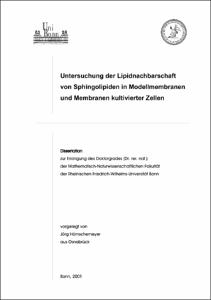Untersuchung der Lipidnachbarschaft von Sphingolipiden in Modellmembranen und Membranen kultivierter Zellen

Untersuchung der Lipidnachbarschaft von Sphingolipiden in Modellmembranen und Membranen kultivierter Zellen

| dc.contributor.advisor | Sandhoff, Konrad | |
| dc.contributor.author | Hörnschemeyer, Jörg | |
| dc.date.accessioned | 2020-04-03T13:39:11Z | |
| dc.date.available | 2020-04-03T13:39:11Z | |
| dc.date.issued | 2001 | |
| dc.identifier.uri | https://hdl.handle.net/20.500.11811/1709 | |
| dc.description.abstract | Membranen eukaryontischer Zellen und ihrer Organellen sind aus einer Vielzahl von verschiedenen Lipid- und Proteinmolekülen zusammengesetzt. Dabei kann es innerhalb der Membranhälften der Lipiddoppelschicht zu einer bestimmten Anordnung bzw. einer Domänenbildung von Lipiden und Proteinen kommen. In der vorliegenden Arbeit wurde untersucht, wie sich die Lipidumgebung von Sphingolipiden im Zuge ihrer Endozytose in kultivierten Zellen verändert. Es wurden dazu photoaktivierbare, radioaktiv-markierte Glucosyl-thio-ceramide (Glc-S-Cer) und Sphingomyeline (SM) synthetisiert, welche nach Belichtung kovalent an eines ihrer direkt benachbarten Moleküle binden. Nach Belichtung der kurzkettigen Glucosyl-thio-ceramide innerhalb der äußeren Schicht der Plasmamembran kultivierter Fibroblasten wird festgestellt, dass sich die Sonden in einer Cholesterol-reichen Umgebung befinden, die auch als Mikrodomänen bzw. "rafts" beschrieben wird. Hingegen werden wenig Kopplungsprodukte mit den anderen Hauptbestandteilen der extrazellulär-orientierten Membranhälfte wie Phosphatidylcholin (PC) oder SM erhalten. Diese bevorzugte Nachbarschaft existiert nur in zellulären Membranen, aber nicht in Modellmembranen, wo keine besondere Affinität der Glc-S-Cer-Sonden zum Cholesterol vorliegt. Nach Endozytose der Sonden werden diese innerhalb der ersten Minuten aus ihrer Lipidumgebung in der Plasmamembran entfernt und befinden sich anschließend auf intrazellulären Vesikeln und inneren Membranen, in denen sie von einer gänzlich anderen Lipidnachbarschaft sind. Nach Belichtung der endozytierten Sonden können vermehrt Kopplungsprodukte mit Phosphoglycerolipiden wie PC und Phosphatidylethanolamin (PE) nachgewiesen werden. Mit den photolabilen Sphingomyelinen wird in Modellmembranen eine Affinität zum Cholesterol gefunden, wie sie auch für endogene Sphingomyeline beschrieben wird. Nach Inkorporation in die Plasmamembran befinden sich die SM-Sonden, ähnlich wie die Glc-S-Cer-Verbindungen ebenfalls in einer Cholesterol-reichen Lipidumgebung. Eine sechsstündige Endozytose und anschließende Belichtung ändert die Zusammensetzung ihrer Lipidnachbarschaft, im Gegensatz zu den Experimenten mit den Glc-S-Cer-Sonden, allerdings kaum. Es kann angenommen werden, dass sich die SM-Sonden im Zuge ihrer Endozytose entweder stets in einer Nachbarschaft mit hohem Cholesterol-Gehalt befinden oder eine besonders hohe Affinität der Sonden zum Sterol zu den entsprechenden Kopplungsmustern führt. | en |
| dc.description.abstract | Examination of the neighbourhood of sphingolipids in model membranes and membranes of cultured cells Membranes of eukaryotic cells and their organelles are composed of a variety of different lipid and protein molecules. Within one plane of the lipid bilayer areas of distinct compositions and domain formation can occur. In this thesis changes of the lipid environment of sphingolipids during endocytosis were examined in cultured cells. Therefore different photoactivatable and radioactive-labeled glucosyl-thio-ceramides (Glc-S-Cer) and sphingomyelins (SM) were synthesized, which upon photolysis bind covalently to their next neighbours in the lipid bilayer.In this thesis changes of the lipid environment of sphingolipids during endocytosis were examined in cultured cells. Therefore different photoactivatable and radioactive-labeled glucosyl-thio-ceramides (Glc-S-Cer) and sphingomyelins (SM) were synthesized, which upon photolysis bind covalently to their next neighbours in the lipid bilayer. It was proven by labelling experiments with short chain photolabile glucosyl-thio-ceramides that after incorporation into the outer plane of the plasma membrane of fibroblasts at 7°C they resided in cholesterol-rich domains also called rafts. Coupling products with other major compounds of the outer layer of the plasma membrane such as phosphatidylcholine (PC) or SM were detected in only small amounts. It was shown that this preferred neighbourhood exists only in cellular but not in model membranes where no affinity of the Glc-S-Cer to cholesterol was measured. Upon endocytosis the photoactivatable lipids were removed from this specific environment in the plasma membrane and were localized on vesicles and intracellular membranes with a different lipid neighbourhood in which upon irradiation coupling products with phosphoglycerolipids such as PC and phosphatidylethanolamin (PE) were detectable in reasonable amounts. The photoactivatable sphingomyelins showed a considerable affinity to cholesterol even in model membranes as described for biological membranes. After incorporation into the outer plane of the plasma membrane of fibroblasts the photoactivatable sphingomyelins were also localized in cholesterol-enriched microdomains. Herein no significant amount of coupling products with other lipids was detectable and remained nearly the same after six hours of endocytosis. In contrast to labelling experiments with the Glc-S-Cer the sphingomyelins were continually confined to the cholesterol environment or the special affinities of the labels have led to these patterns of coupling products. | en |
| dc.language.iso | deu | |
| dc.rights | In Copyright | |
| dc.rights.uri | http://rightsstatements.org/vocab/InC/1.0/ | |
| dc.subject | Sphingolipid | |
| dc.subject | photoaktivierbar | |
| dc.subject | Membranen | |
| dc.subject | Mikrodomänen | |
| dc.subject.ddc | 540 Chemie | |
| dc.subject.ddc | 570 Biowissenschaften, Biologie | |
| dc.title | Untersuchung der Lipidnachbarschaft von Sphingolipiden in Modellmembranen und Membranen kultivierter Zellen | |
| dc.type | Dissertation oder Habilitation | |
| dc.publisher.name | Universitäts- und Landesbibliothek Bonn | |
| dc.publisher.location | Bonn | |
| dc.rights.accessRights | openAccess | |
| dc.identifier.urn | https://nbn-resolving.org/urn:nbn:de:hbz:5n-00506 | |
| ulbbn.pubtype | Erstveröffentlichung | |
| ulbbnediss.affiliation.name | Rheinische Friedrich-Wilhelms-Universität Bonn | |
| ulbbnediss.affiliation.location | Bonn | |
| ulbbnediss.thesis.level | Dissertation | |
| ulbbnediss.dissID | 50 | |
| ulbbnediss.date.accepted | 19.12.2001 | |
| ulbbnediss.institute | Mathematisch-Naturwissenschaftliche Fakultät : Fachgruppe Chemie / Kekulé-Institut für Organische Chemie und Biochemie | |
| ulbbnediss.fakultaet | Mathematisch-Naturwissenschaftliche Fakultät | |
| dc.contributor.coReferee | van Echten-Deckert, Gerhild |
Dateien zu dieser Ressource
Das Dokument erscheint in:
-
E-Dissertationen (4337)




